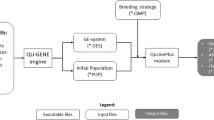Summary
Three recurrent selection schemes suitable for kale (Brassica oleracea L.), involving half-sib (HS), full-sib (FS) and selfed (S) families, were compared by computer simulation. All combinations of 6, 12 and 24 families selected, out of 120 and 240 assessed, were investigated for a range of genetical models. Selection was simulated for 20 generations from an initial allele frequency of 0.05 and for 16 generations from an initial frequency of 0.20. With an initial frequency of 0.05 there was a serious loss of desired alleles ranging from 0.31 out of 20 for the HS scheme with 24 out of 240 families selected to 9.19 for the S scheme with 6 out of 120 families selected. It was concluded that if as many as 20 cultivars were included in the initial population the selection scheme should be chosen to minimise the loss. With an initial frequency of 0.20 there were no losses with 12 and 24 families selected in the HS and FS schemes respectively, and the highest loss was 2.88 for the S scheme with 6 out of 120 families selected. It was concluded that if as few as five cultivars were included in the initial population a compromise between the initial response to selection and the loss of desired alleles should be sought. Selecting 6, 12 and 24 families for the HS, FS and S schemes respectively, resulted in average relative responses per generation of 2.28, 2.74 and 2.76, respectively for the first five generations, and losses of 0.22, 0.13 and 0.35, respectively after 16 generations. Practical considerations favour the FS scheme over the S scheme.
Similar content being viewed by others
References
Bradshaw JE, Mackay GR (1981) Kale population improvement and cultivar production: In: Gallais A (ed) Quantitative genetics and breeding methods. Eucarpia Proc 4th Meeting Sec Biomet Plant Breed, pp 71–76
Choo TM, Kannenberg LW (1979a) Relative efficiencies of population improvement methods in corn: a simulation study. Crop Sci 19:179–185
Choo TM, Kannenberg LW (1979b) Changes in gene frequency during mass, modified ear-to-row, and S1 selection: a simulation study. Crop Sci 19:503–509
Fraser A, Burnell D (1970) Computer models in genetics. McGraw-Hill, New York
Hallauer AR, Miranda JB (1981) Quantitative genetics in maize breeding. Iowa State University Press, Ames Iowa
Nguyen HT, Sleper DA (1983) Theory and application of half-sib matings in forage grass breeding. Theor Appl Genet 64:187–196
Taylor JP (1982) Carbon dioxide treatment as an effective aid to the production of selfed seed in kale and Brussels sprouts. Euphytica 31:957–964
Wichmann BA, Hill ID (1982) An efficient and portable pseudo-random number generator. Appl Stat 31:188–190
Wright AJ (1980) The expected efficiencies of half-sib, testcross and S1 progeny testing methods in single population improvement. Heredity 45:361–376
Author information
Authors and Affiliations
Additional information
Communicated by Å. Gustafsson
Rights and permissions
About this article
Cite this article
Bradshaw, J.E. Computer simulation of family selection schemes suitable for kale (Brassica oleracea L.), involving half-sib, full-sib and selfed families. Theoret. Appl. Genetics 68, 503–508 (1984). https://doi.org/10.1007/BF00284998
Received:
Accepted:
Issue Date:
DOI: https://doi.org/10.1007/BF00284998




